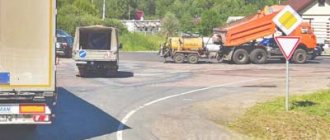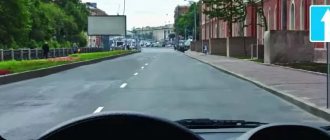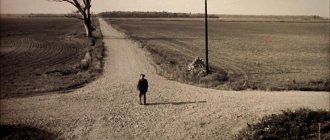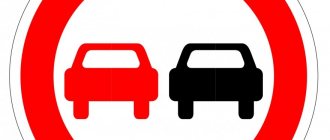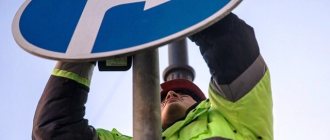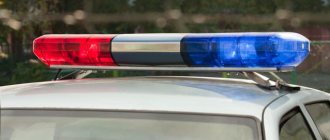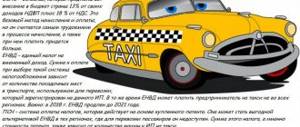Priority signs
Since the road sign indicating the main road is in the group of priority ones, it would be useful to understand what their essence is. The group is relatively small, but at the same time it has no less importance in traffic rules than a warning one.
Which signs are priority:
- Main road – defines the area where the right of way is provided. Used at intersections without regulation.
- End of main road sign – used to indicate the end of the main road.
- Intersection with a minor road – informs you about the intersection of your road with a minor road at the next intersection.
- Junction of a secondary road - its meaning coincides with the previous sign. The difference lies in the adjoining of the road to yours from one of the directions.
- Give way - at an uncontrolled intersection you must not interfere with the movement of motorists moving along the main road.
- Driving without stopping is prohibited - analogous to the sign of giving way. Requires you to stop before crossing an intersection.
- The advantage of oncoming traffic is that it is installed on narrow parts of roads. The sign requires you to give way to motorists in the oncoming lane.
- Advantage over oncoming traffic, on the contrary, provides the right of passage on a narrowed road. But if oncoming cars have already entered the lane, you need to let them pass.
This is a complete list of priority signs that motorists need to know. They do not prohibit, but give instructions for action.
Now let's take a closer look at what a secondary and main road is, and how to understand the sign that marks it.
Plate 8.13 “Main Road Direction”
Plate 8.13 “Main Road Direction” is used to indicate the direction of the main road at an intersection where it changes direction. Table 8.13 is used with signs 2.1 “Main road”, 2.4 “Give way” and 2.5 “Driving without stopping is prohibited”.
When placing signs on posts, the sign is placed under the sign. When placing signs on cantilever supports or above a roadway, shoulder or sidewalk, the sign is placed to the right of the sign.
Rules for driving through intersections where the main road changes its direction are regulated by clause 13.10 of the traffic rules. The series of publications “The Main Road” is devoted to driving through such intersections.
Appearance and installation of the sign
The “main road” is manufactured in accordance with GOST and has the appearance of a yellow diamond. The borders of the diamond are made in white and have the same width. Outwardly, it is known to many people, since it is quite often found in cities.
This is what the picture of the “Main Road” sign looks like:
When placing a main road sign, the distance to the starting point of the action is taken into account. This means that it is placed immediately before the intersection with the main road.
The repetition of signs before subsequent intersections is due to the actions of signs indicating a yield, intersection or junction. They are installed in front of the exit point from adjacent streets. They do not indicate priority, but only ask to give way. The main sign is duplicated in order to supplement information about the road.
Instead of repeating a priority road sign, a junction sign is often used. It is placed at some distance from the intersection. That is why this combination is more often used outside populated areas.
By the way, within the city limits there must be a duplication of the “Main Road” at every intersection. This is due to the coverage area that is listed at the installation location. If the sign is located behind the intersection, then it is valid throughout the journey. The end of the main road is indicated by a corresponding sign (2.2). But we must remember that this does not make the road secondary. Only the intersection of equivalent roads is determined.
Driver's reminder: everything about the "Main Road" sign
Almost all roads in our country have a large number of special signs. These marks are designed to help the driver drive safely and not pose a threat to other road users.
One of the main inanimate assistants to the driver are priority indicators. They tell who has the advantage on the roadway, who has the right to pass first and, therefore, on whose side the law enforcement officers are most likely to be in the event of an accident.
One of the most common marks is the "Main Road" sign.
Number
In the set of traffic rules this sign is listed as number 2.1.
Appearance
The road sign “Main Road” is easy to recognize among others. It is made in the shape of a rhombus. The inside of this sign is yellow and has a white frame.
Coverage area
The “Main Road” sign applies to the section of the route up to the first intersection along the route.
However, sometimes, to make drivers more confident, a sign is also installed on the roads, indicating the end of the coverage area of the advantage. It looks like pointer 2.1, but has the number 2.2 and the diamond in this case will be crossed out.
Concept and meaning
The concept of a main road is established by the definition of traffic rules. According to the law, the main road is a section of the roadway on which priority of passage is established relative to secondary roads. A secondary road is a road adjacent to or intersecting the main one. These are all kinds of access routes, alleys, driveways and other routes.
As a rule, the main road is marked with specially designated road signs. And also the main part is the part that has a hard coating in relation to the primer.
A priority sign installed in front of an intersection gives the right of priority passage only at that intersection. It is often duplicated at subsequent intersections. Therefore, to determine the coverage area, another sign is installed - a crossed out yellow diamond, which means that the main road ends, but it is not placed in every case.
When there is an intersection after a crossed out sign, according to the rules it is considered equivalent. In this case, the right of passage is determined by an obstacle on the right or by the surface of the roadway. If the road is covered with asphalt and wide, it is the main one, and if it is covered with a primer, then the driver must give way when driving along it.
The end of the main road sign, combined with a yield sign, means that the motorist is obliged to allow other drivers to pass.
It is known that priority signs cannot prohibit any actions by drivers, but only indicate who has priority when driving through uncontrolled intersections. But the main road sign, installed outside populated areas, prohibits standing on this section. That is, you cannot stop in the middle of the highway for personal needs, the only exception being emergency situations. In case of violation, you will face administrative punishment. Therefore, wait until parking spots appear on the way and park calmly.
It is possible to install a sign together with a sign indicating the direction. This is done where equal and unequal intersections intersect. This combination also regulates the movement of pedestrians and is installed together with the designation of a pedestrian crossing. When approaching such intersections, you must slow down in advance and be more careful. The absence of a direction sign indicates the straightness of the road.
Many drivers find it difficult to organize their actions when changing direction. The fact is that when they see a sign defining the main road, they assume the right of way. But what to do in a situation where two motorists standing on opposite sides of the intersection believe that they have the right to pass?
How to act when changing the direction of the main road at an intersection:
- When moving, think not only about yourself, but also about other motorists. Take a closer look at the addition - plate 8.13, indicating the direction.
- Visually position the sign in the center of the intersection, then you will see that the wide stripe shows the priority road, and the narrow stripes show the secondary road.
- Having excluded the thin stripes “in the head”, leave only the main part in mind. Then the second participant in the movement and you will act according to the rule of interference on the right. The one who has no obstacle starts the movement.
In the same way, you can mentally divide the site into two halves for travel.
the main road
The “Main Road” sign designates a road on which vehicles are given the right of way through uncontrolled intersections. Those. Cars on the main road have priority over cars on the secondary road.
If the “Main Road” road sign is installed in front of an intersection without an additional sign, this indicates that the main road passes through the intersection in the direct direction.
Another feature of the main road sign is its coverage area. The road remains the main one until the sign “end of the main road” appears on it. There are no other conditions for canceling this sign in the traffic rules.
Note. Outside populated areas, on roads marked with a main road sign, parking on the roadway is prohibited.
Roundabout
You can only move at a roundabout intersection in a counterclockwise direction.
It is indicated by a blue circle with arrows. There are dividing stripes on the ring. Additionally, the area is regulated by other signs, for example, “give way” or “driving without stopping is prohibited.” This combination of symbols indicates that the driver already in the circular lane has the advantage. Sometimes the above signs are supplemented with a yellow diamond - indicating the main road. It is placed along with a direction sign. It depicts the entire ring or part of it, indicating where the priority road begins its operation.
The part of the circle shown on the sign must be remembered, because this is where the main road ends and the driver at the intersection gives way to those entering, according to the rule of interference on the right.
If the intersection is controlled, this greatly simplifies the driving process. The installed traffic light works the same as at a regular intersection - red prohibits, green allows through.
The main thing is, when entering the roundabout, decide in advance which lane you will occupy. It depends on which direction you plan to leave the intersection. The traffic rules establish the entry rule - from any lane of the adjacent road.
Conditions for selecting the correct band:
- if you are going to leave the circle to the right or move straight, choose the lane on the right edge;
- if you plan to make a left turn from the roundabout or turn around in the opposite direction, take the lane on the left;
- when the number of lanes is three or more, the lanes in the center are occupied when moving through the ring along a straight path.
It is a mistaken belief that you need to turn left when entering the roundabout. It is required to use the right one not only when entering, but also when leaving. A left turn signal is only required when changing lanes or making a U-turn. Turning on the turn signals is not required when crossing the ring.
Punishment for violation
Remember that any violation of traffic rules is subject to appropriate punishment.
Violation of the requirements of a main road sign and failure to provide an advantage to other road users faces a fine under the Code of Administrative Offenses of the Russian Federation in the amount of 1,000 rubles. If the traffic police officers on duty notice such a violation, they will certainly draw up a report on you. It is good if this maneuver does not entail the creation of a dangerous or emergency situation. Then the penalty may become larger, and this is in addition to the costs incurred in the event of a possible accident.
Such violations are more likely to lead to an accident. Therefore, before driving along the main road, you need to make sure that other participants give way to you from all adjacent roads. This is the only way to avoid a collision and pass through the intersection unhindered.
Even when you follow the rules and move in the right direction, it is important to remember that a motorist driving on the secondary road could easily make a mistake or not know the rules at all. You need to be completely sure that they have given way to you and only then continue moving.
Only responsibility and a sober mind will allow you to drive a car safely. The main thing is not to forget that there are other road users who, in turn, can ignore road signs.
